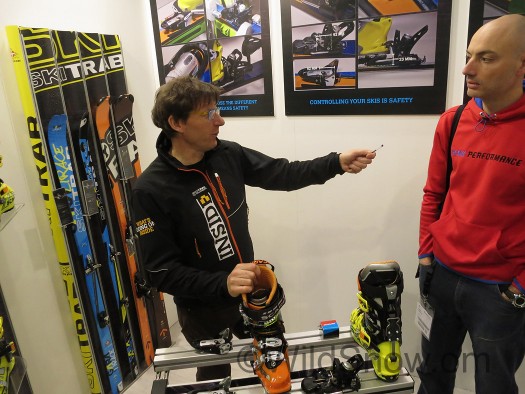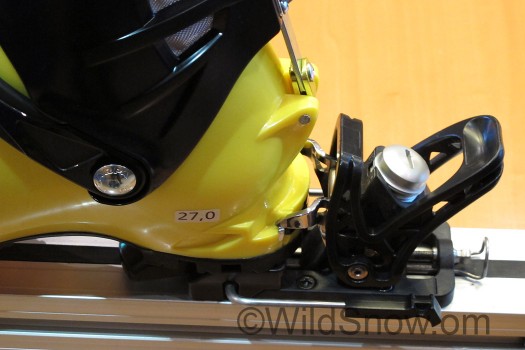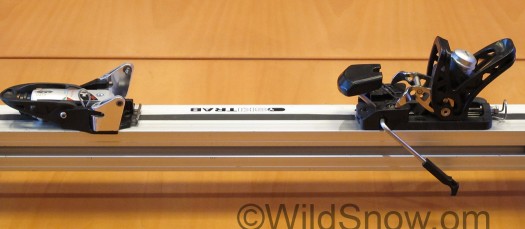
Ski Trab co-owner Adriano Trabucchi holding forth on their now-ready-for-prime-time TR2 ski binding.
I was perplexed. Several years ago, the first time I saw a ski binding in development at Trab in Italy, it was big. Then they come up with their TR2 klunker–still big. This from a company that produces some of the best minimalist skis on the planet, as well as a corporate culture that one has to assume requires everyone to sport their lycra skimo “skin” race suits at sales meetings.
We of course mentioned this contradiction in our previous Trab TR2 blog post — and my perplxity did not go unnoticed by the boys of Bormio. First thing Adriano mentioned when I entered the Trab booth yesterday at ISPO Munich: “Lou, let me explain why we made a heavier binding.”
According to Adriano, for a normal tech binding to work correctly your ski boot needs a good amount of torsional (twisting) rigidity in the lower shoe (scaffo) due to it being held from such motion nearly entirely by the binding toe unit. Thus, the design philosophy for lightweight gear has thus far been 1.) super light tech binding 2.) fairly light ski 3.) medium weight boot that has some rigidity. But today’s lightweight boots have skewed the paradigm.
These days, said Adriano, due to boots getting so light you see skiers coming down the hill with exaggerated angulation and edging. Unless they’re an agile expert skier, they may struggle.
I’d agree. More and more often I’m seeing skiers on tech binding systems compensating for boots that twist and lean like an old leather telemark boot on a 3-pin nordic binding (which, incidentally, was probably why telemarkers of yore presented incredibly exaggerated angulation).
Thus, the paradigm has changed for skiers desiring faster and stronger “freeride touring” performance. Solution? Boot design engineers need to continue their quest to build twist-resistant but lightweight shoes (recent offerings with carbon or metal reinforcements are examples). But according to Trab, the simple and effective answer is a binding that holds the boot with a wider pattern at the heel, with no twisting or wobble (and incidentally, none of the rotation that normal tech binding heels have to allow for elasticity.

Trab TR2 has super firm heel hold-down due to wider width of jaws as well as no need for binding heel rotation left-right.
As many of you know, a few years ago we began our call for “tech 2.0” that had exactly the above feature; a wider more solid heel hold. We’re not sure if TR2 is the 2.0 of the tech system, since it breaks the faux “tech” “pintech” standard and requires proprietary heel and toe fittings on boots presently only supplied by Scarpa. Nonetheless, if a lightweight gear company such as Trab is thinking along these lines, the ski touring binding industry could become WAY more interesting — as if it’s not interesting enough already!
One other thing, and this could be BIG. Adriano told me they worked hard on making a binding that could be TUV certified to the existing DIN/ISO standards for ski touring bindings. Problem was, this required energy absorption in the toe (elasticity) that is difficult to achieve without extra machinery and weight to compensate for the limitations of using “tech” similar binding fittings in the boot toe. Thus, Adriano said, they’re _not_ going for TUV certification but rather did their own 2 years of intense field testing for safety and performance, and they’re super confident the TR2 fit the bill.
There you go. None other than Ski Trab (in partnership with Scarpa) comes up with the first viable challenge to the tech system. Not only that, but they blow off TUV and the archaic DIN/ISO ski touring binding standards. Leadership? Yes. Noticed by every binding engineer in the ski touring industry? You bet. Italian skimo anarchists? Probably.
More WildSnow blog posts about Ski Trab, including our visit a few years ago.
Facts, same as we placed on previous blog post:
Factoids:
– Weight, 580 grams including what appears to be the standard >< 88mm ski brake.
– Max release value: This season model goes from RV 5 to 11. Next season a 7/13 model will be available.
– Not tech system compatible, is its own proprietary system that requires dedicated boots.
– Available boot will be 3-buckle Scarpa Spirit TR2, about 475.00 euros.
– Next season a stiffer boot will be on tap, 4-buckle Scarpa Spirit RS TR2, about 535.00 euros.
– Boot length adjustment range: 23 mm.
– Brake widths available this season: 88, 104, with 115 next season.
– MSRP about 449.00 euros
WildSnow.com publisher emeritus and founder Lou (Louis Dawson) has a 50+ years career in climbing, backcountry skiing and ski mountaineering. He was the first person in history to ski down all 54 Colorado 14,000-foot peaks, has authored numerous books about about backcountry skiing, and has skied from the summit of Denali in Alaska, North America’s highest mountain.

